Introduction and the Caddo Involvement in the Lake Naconiche Project
In the spring of 2004, the Caddo Nation received a phone call from county officials representing Nacogdoches County, Texas, about the archeological discovery of human remains from burial features at two of the Caddo sites (Tallow Grove and Beech Ridge) then being investigated at the proposed Lake Naconiche project by Archeological & Environmental Consultants, LLC. Caddo Nation representatives were invited to visit and tour the areas with county officials where the human remains were discovered during the archeological excavations .
This timely notification from the County of Nacogdoches was in large part due to productive consultations that had first taken place beginning in 1999, with the initiation of the archeological project, and continued through the 2000-2001 test excavations at a series of prehistoric Woodland and Caddo sites to be affected by the development of Lake Naconiche. As part of their compliance with Section 106 of the National Historic Preservation Act (NHPA), the lead federal agency, the National Resources Conservation Service (NRCS) provided the archeological survey and test excavation reports from Lake Naconiche to the Caddo Nation’s Tribal Historic Preservation Officer (THPO) for review and comments.
In response to the NRCS recommendations for further study to determine the eligibility of several sites for inclusion in the National Register of Historic Places (NRHP), the THPO raised several issues regarding sites that had the potential to be NRHP eligible and sites that were recommended by the contractor for data recovery work before the lake project was to be completed. These comments were also discussed in conference calls with the Texas Historical Commission (THC) and County of Nacogdoches officials. Our comments reflected a positive endorsement of the proposed research design on the work remaining to be conducted. The archeological research design also included stipulations pertaining to the discovery of graves and/or cemeteries at the sites that were likely to be culturally affiliated to the Caddo Nation, as well as to the need for consultation regarding the repatriation of any recovered human remains and associated funerary objects after they had been fully studied and documented by qualified Caddo archeologists and bioarcheologists.
From several initial meetings through the course of the project, and after it was determined that a number of prehistoric Caddo sites were eligible for the NRHP and were to be adversely affected by project developments, it was decided that a Memorandum of Agreement (MOA) be developed with the Caddo Nation, the NRCS, the County of Nacogdoches, and the THC, with each entity a signatory to the MOA. This agreement was in large part the product of the Caddo Nation being well advised and informed in advance by Archeological & Environment Consultants, LLC, who conducted the archeological survey and NRHP testing for the proposed lake on behalf of the county. Tribal member participation in the archeological investigations was encouraged; tribal representatives had previously been involved in the 2000-2001 test excavation phase at some of the Lake Naconiche sites.
The Tribal Historic Preservation Officer (THPO), as the liaison to the Caddo Nation Tribal Council, educated the Council on the nature of the Lake Naconiche project. Our Repatriation Committee (made up of a group of traditional elders), also served an important role in the consultation process for the Lake Naconiche project. The Repatriation Committee advises the THPO and the Native American Graves Protection and Repatriation Act (NAGPRA) Coordinator on how to proceed with sensitive cultural matters regarding any projects or sites that may contain Caddo graves, cemeteries, or traditional cultural properties.
The Caddo Nation and Repatriation
Since the passage of the NAGPRA in 1990, the Caddo Nation of Oklahoma has repatriated hundreds of sets of prehistoric and historic Caddo human remains and thousands of associated and unassociated funerary objects, among those the human remains and funerary objects from several burials at three Lake Naconiche sites. At least 130 museum facilities have human remains and funerary objects culturally affiliated to the Caddo. Repatriation of human remains and funerary objects is thus very important to the Caddo Nation.
The Caddo have one primary burial tradition with particularly important implications for the repatriation and reburial of human remains and funerary objects. Caddo spiritual belief dictates that funerary objects (such as ceramic vessels) are to be placed in the grave of the deceased person as containers to hold and provide sustenance for them on their journey in the afterlife. If these objects are separated from the person, the Caddo believe that this journey has been interrupted. A large part of our NAGPRA work is spent obtaining information and documentation to reunite funerary objects with human remains so they can then be reburied to fulfill this traditional Caddo need. Sometimes, unfortunately, this cannot be accomplished because of the great dispersion of human remains and funerary offerings from sites and burials among several different museum facilities.
The Caddo peoples lived in contiguous portions of Arkansas, Louisiana, Oklahoma and Texas (an area of about 180,000 square km) from time immemorial until they were removed—first by treaty with the United States of America in 1835, and then through force of arms from the Brazos Reserve by Texans in 1859—from their traditional homelands and forced to resettle in western Oklahoma. This painful history of forced migration gives contemporary repatriation efforts such as those associated with the Lake Naconiche project particular significance.
The Caddo Nation Repatriation Committee was formed through a tribal resolution in 1996. The committee consists of traditional elders that still speak the language and actively participate in hosting and attending annual dances; teaching Caddo songs and dances to young people; and performing the reburial ceremonies of human remains and associated funerary objects culturally affiliated to the Caddo Nation under NAGPRA. The committee has been instrumental in providing insight and guidance by attending regular meetings with Caddo Nation Cultural Preservation Department (CPD) staff and addressing the sensitive issues of repatriation, burial practices and traditions, reburial of human remains and associated funerary objects, and the education of the general public about the Caddo through exhibits in the Caddo Nation Heritage Museum in Binger, Oklahoma.
Through input from the Repatriation Committee, the Caddo’s CPD has developed agreements with museums and repositories that have collections in their possession and control that fall under NAGPRA regulation. These agreements focus on the treatment, care and handling of Caddo funerary objects, objects of cultural patrimony, and sacred objects, with an emphasis on insuring the traditional treatment of items in the collections. For example, the Caddo believe that a light of some sort should be left on where any human remains are being housed. To date, the Caddo have agreements with Northwestern State University (in Natchitoches, Louisiana), the Sam Noble Oklahoma Museum of Natural History at the University of Oklahoma, the Texas Archeological Research Laboratory at the University of Texas, and the Arkansas Archeological Survey.
Through these agreements and consultations, the Repatriation Committee has had an important role in consultations addressing the analysis of human remains and funerary objects in archeological research being done on Caddo sites and with collections from the Caddo Nation’s original homelands. One of the stipulations of the agreements addresses the need for students and researchers interested in doing work with any collections defined as being culturally affiliated with the Caddo to consult with the Caddo before beginning a research project where these collections may be needed as part of ongoing research or comparative analysis. There are a handful of archeologists and anthropologists with an interest in the Caddo who have requested input on a variety of research proposals, ranging from documenting the temporal and spatial distributions of Caddo pottery found in burials; to determining the importance of maize in the prehistoric Caddo diet; and to bioarcheological analysis of human crania, especially the distinctive Caddo practice of cranial modeling. The Lake Naconiche research design prepared by A&E, LLC for the study of any Caddo burial features, human remains, and/or associated funerary objects was prepared with these consultation needs in mind.
The Repatriation Committee makes its recommendations of support or opposition to these proposals and analyses on a case-by-case basis. Oftentimes, a researcher may presuppose that the Repatriation Committee will deny any request involving the analysis of human remains; however, this historically has not been the case. Any types of destructive analysis of human remains (for purposes of radiocarbon dating or isotope analysis) certainly tend to be taboo, but there have been several instances where the Repatriation Committee has approved destructive analysis. Both radiocarbon dating and isotope analysis were completed on recovered human remains from burial features at three Lake Naconiche sites, and the analyses obtained important and unique information on prehistoric Caddo health and subsistence, especially the importance of maize consumption in the diet of the prehistoric Naconiche Caddo.
Through this collaborative process, which worked well at Lake Naconiche, researchers who plan to work with collections that are culturally affiliated to the Caddo quickly learn they must communicate effectively, be ready to ask and answer many questions, and be prepared to consult appropriately about their specific research interests. They must also be prepared to share their results with the committee, and to have their findings scrutinized by the CPD and our archeological consultants. This collegial process of consultation and information-sharing helps to not only better prepare graduate students for their future in the discipline, but also to better prepare our staff and committee members for understanding the variety of complex research approaches being proposed by universities and repositories continuing to work with collections affiliated with Native American tribes.
The actual repatriation of human remains, funerary objects, sacred objects, and objects of cultural patrimony has been variable for the Caddo Nation over the years. In some cases putting all the pieces of a NAGPRA puzzle back together, such as finding which institution has human remains and which institution (that just happens to be a thousand miles away) has associated funerary objects, is a daunting task. We have completed NAGPRA repatriations that took years of careful negotiation to accomplish, and we have also repatriated skulls and funerary objects while standing in a parking lot. In that particular non-NAGPRA case, the human remains and objects had been given to an individual from a known looter, who then returned them to us.
We have also repatriated human remains and funerary objects under the National Museum of the American Indian Act from the Natchitoches National Fish Hatchery in Louisiana, and have collaborated with a wide variety of other government entities on repatriation efforts in recent years, including NRCS and the County of Nacogdoches for the Lake Naconiche project. Working in conjunction with representatives of the Federal Highway Administration and the Texas Department of Transportation, after five years of consultation the Caddo were able to see that 27 individuals and their associated funerary objects, recovered in excavations at a sixteenth- and seventeenth-century Caddo cemetery, were reburied in a local cemetery in Mount Pleasant, Texas.
These repatriations are milestones for the Caddo people. Having ancestral Caddo remains and funerary objects finally treated with some modicum of respect is a large part of what the CPD, the Repatriation Committee, and the Caddo Nation strive to achieve.
Caddo Burial Features at Lake Naconiche and Repatriation Efforts
Prior to the spring 2004 identification of burial features (some with preserved human remains and/or associated funerary objects, including ceramic vessels and stone tools) from the Tallow Grove and Beech Ridge sites, a prehistoric Caddo burial feature with an associated Holly Fine Engraved vessel was identified at the Boyette site (41NA285) in the winter of 2003. Due to issues of security, poor weather conditions that could affect any exposed human remains, and the fact that protecting the burial would be difficult because the site was so isolated, A&E, LLC recommended to the MOA consulting parties that the removal of the individual and associated funerary objects from the site be done expeditiously.
The Caddo Nation concurred. The THPO and NAGPRA coordinator paid a visit to the site a short time later, after the excavations had been completed by A&E, LLC. Using green cedar that tribal representatives had prayed over according to tribal wishes and protocol, the area where the burials had been removed was cedared from a fire that was placed adjacent to the excavation area. The archeologists involved in the excavations of the burials were also allowed to use the cedar. Archeological investigations continued in habitation areas at the site with the invited participation of the NAGPRA Coordinator and the THPO. The THPO then took it upon himself to return on a separate occasion (during his vacation time) to continue his direct involvement in the Lake Naconiche data recovery field work.
As mentioned above, prehistoric Caddo human remains were encountered on the Lake Naconiche project later in the spring of 2004, during the data recovery excavations at the Tallow Grove (41NA231) and Beech Ridge (41NA242) sites, the same sites where human remains had been encountered in 1999 during the archeological survey investigations. Then, the Chairperson of the Caddo Nation received a phone call from County of Nacogdoches officials regarding the identification of additional burial features at the two sites. The Tribal Council and Repatriation Committee were again briefed on the discovery, and emergency travel to the project area and site location by the THPO and the NAGPRA Coordinator was approved through the Tribal Council.
Once Caddo Nation representatives arrived in Nacogdoches, they visited with county officials at the courthouse and then traveled to the two adjacent sites along Naconiche Creek to consult with the archeologists regarding the burials that had already been and were being excavated and removed as part of the data recovery work. All associated costs of the visit by the Caddo Nation were paid for by Nacogdoches County.
Caddo Nation representatives were informed by county officials that the County of Nacogdoches, would do the right thing in regards to the re-interment of the Caddo burials removed from the Lake Naconiche project area. The wishes of the Caddo Nation were that the human remains, associated funerary objects, and associated burial fill should be reburied in a safe and protected area closest to where they originally were encountered.
After the conclusion of the data recovery work at Lake Naconiche, County officials discussed with the Caddo Nation the possibility of using a small portion of land within the proposed park area at Lake Naconiche as a dedicated reburial area. The 35 acre tract of land was visited and two possible locations were identified, the first area being in the southeast corner of the proposed park on a small rise along the southeast corner fence line. The second area was in a low-lying area. Photographs were taken of both areas and county officials provided the Caddo, for their consideration, a map of the area.
Representatives of the Caddo Nation discussed both proposed areas with the Repatriation Committee and the Tribal Council, and provided them the map of the area and photographs taken of the proposed reburial areas. A&E, LLC was also consulted with regard to providing any relevant archeological information about these defined places within the project area, and neither area contained archeological remains.
Over the years since 2004, several possibilities were discussed with the Tribal Council and the Repatriation Committee regarding the proposed reburial areas at Lake Naconiche. Discussions included the need for a granite marker within the cemetery area that would commemorate the Caddo who once occupied the area. A possible walkway around the reburial area with a Caddo Nation flagpole and flag flying was also considered. It was hoped at least this would be one small way to educate the Lake Naconiche visitors on the presence and history of the Caddo people in this part of East Texas.
A priority of the Caddo Nation tribal government has always been to protect the graves of their ancestors and to keep them from ever being dug up again. Due to time constraints in constructing this proposed park at Lake Naconiche, the Caddo Nation decided in further consultations with the NRCS and the County of Nacogdoches that in the best interest of the human remains, they needed to be reburied in a secured place in a marked cemetery. These human remains, associated sediments from the burial fill, and their associated funerary objects were reburied in a nearby cemetery within the local community of Nacogdoches, Texas, not too distant from their original resting place.
Lake Naconiche Re-Interment Ceremony
The re-interment of the Caddo human remains and associated funerary objects excavated at Lake Naconiche in 2003-2004 took place March 2, 2011, at the Sunset Ceremony in Nacogdoches, Texas. The remains were finally laid to rest in a moving ceremony led by Lyman Kionute.
Travel funds for the Caddo Nation representatives to attend the repatriation were provided by the County of Nacogdoches and the Bureau of Indian Affairs. Nacogdoches County officials were able to secure the burial plot through donation.
In attendance for the Caddo Nation of Oklahoma were Brenda Edwards, Chairperson of the Caddo Nation, Bobby J. Gonzalez, NAGPRA Coordinator for the Caddo Nation, Robert Cast, Tribal Historic Preservation Officer for the Caddo Nation, and members of the Caddo Nation’s Reburial Committee, including Lyman Kionute, Caddo ceremonial leader. The city and county of Nacogdoches had representatives in attendance, including George Campbell, retired land agent for the county, as did the USDA, Natural Resources Conservation Service, including Calvin B. Sanders. John Worthington, archeologist with the Bureau of Indian Affairs, Southern Plains Region, attended, as did archeologists that worked on the Lake Naconiche project; representatives of Stephen F. Austin State University were also among the attendees.
|
A Government-to-Government Relationship exists between the Caddo Nation, United States Department of Agriculture, Natural Resources Conservation Service (NRCS), County of Nacogdoches, Texas, and the Texas Historical Commission.
|
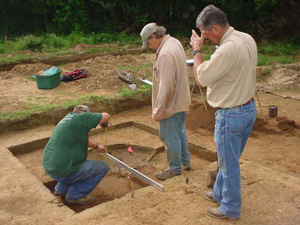
The Caddo THPO measuring the depth of a storage/trash pit feature at the Tallow Grove site (41NA231), observed by the Archeological Principal Investigator, and County of Nacogdoches official.  |
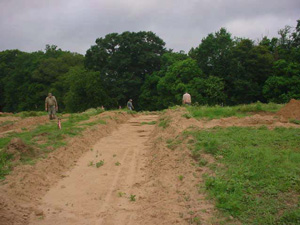
Picture of archeological crew looking west on top of the hill at the Beech Ridge site (41NA242), south of the two burial features. 
|
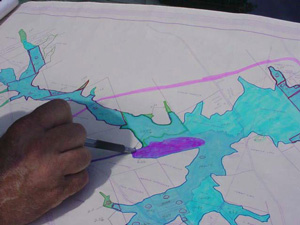
Map showing location of the proposed park area at Lake Naconiche initially proposed for the re-interment of human remains and associated funerary objects removed from three project area sites.  |
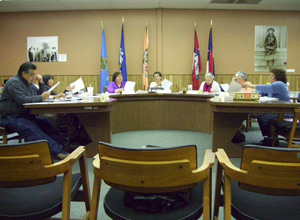
Caddo Nation Tribal Council in tribal chamber headquarters in Binger, Oklahoma.  |
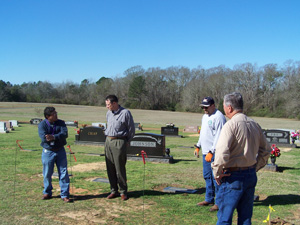
Bobby Gonzalez (far left), George Campbell (far right), and Nacogdoches County officials conferring before the re-interment trench was excavated.  |
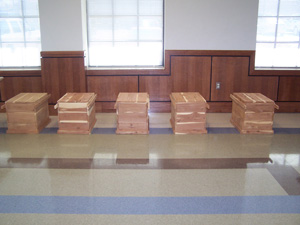
Five of the eight cedar boxes to be used in the re-interment. Human remains, any associated funerary objects, and associated dirt collected from the fill of each burial at Lake Naconiche, were put separately in each box.  |
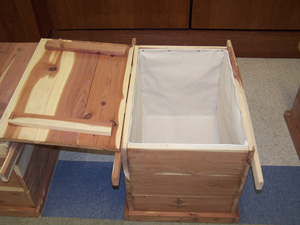
Interior of one of the cedar boxes.  |
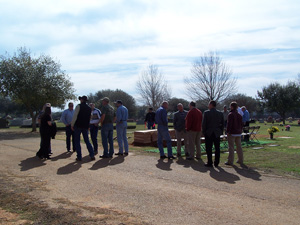
Attendees gather before the re-interment ceremony.  |
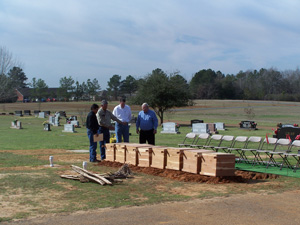
Cedar boxes ready for re-interment. The re-interment trench lies due west of the boxes. Bobby Gonzalez, George Campbell, and other Nacogdoches County officials conferring.  |
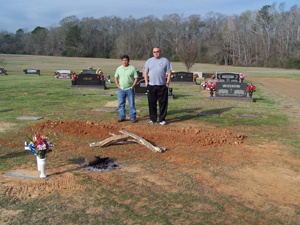
Bobby Gonzalez and John Worthington, the next day, at the filled in re-interment trench for the burials excavated at Lake Naconiche.  |
|